

Village Life in the 1920's
Upwey in the 1920's was a more or less self-
The National Omnibus Transport Company arrived in Weymouth in 1923 and began a bus service between Weymouth, Sherborne and Yeovil passing through the village.
The horse was still a common form of transport either with a cart, wagon or trap. Many people had bicycles, some were proud owners of motorcycles, the 'gentry' had cars.
Elwell Street was the 'shopping centre' of the village, the post and telegraph office being run by Miss Corbin. Inside the post office was a wooden telephone kiosk where you could make calls. If you were lucky and the post office wasn't busy Miss Corbin would make the call for you.
A mail sorting room was attached to the side of the building and letters were franked with an 'Upwey' postmark. Telegrams received at the post office were delivered over an area from Nottington to Portesham -
Other shops in the street included Times grocery stores run by the Barbers, Trevetts coal merchants, Bowditch the butcher and market gardens at either end of the street.
Mr Bowditch, the butcher, bought live animals at market held on Wednesdays and Saturdays in Dorchester, kept them in a field behind the Mason's Arms and slaughtered them as they were needed. The carcasses were hung from meat hooks in the passageway that formed his shop at number 40.
Mr Cox came out from Weymouth with a horse and cart to sell oil for heaters, stoves and lamps.
The Reading Room at the western end of Elwell Street (next to number 88), was founded by Canon Gildea and gifted to the parish in 1906. Built of corrugated iron and brick as a meeting place for the young men of the village. Open in the evenings, to provide youths with recreational studies as an alternative to the attractions of the highway or tap room. Daily and weekly papers and magazines; draughts; dominoes and cards were available. Two flags hung at the end of the room. It was also used for various meetings and events.
Just around the corner in Church Street were the 'twelve apostles', a group of very tall fir trees.
Gradually over the years their number dwindled as they either fell or had to be taken down for
safety reasons -
Mrs Samways sold just about everything in the grocery line at the Wishing Well Stores (84 Church Street).
Milk could be obtained from various sources; Alf White was a milkman working for Ray Rogers who had the dairy at the junction of Jesty's Avenue and Old Station Road. Bert Legg, one of the five sons from Icen Farm, carried milk churns on specially made platforms built onto the side of his bicycle. He'd arrive at your door with a pail of milk and using measures fill your jug.
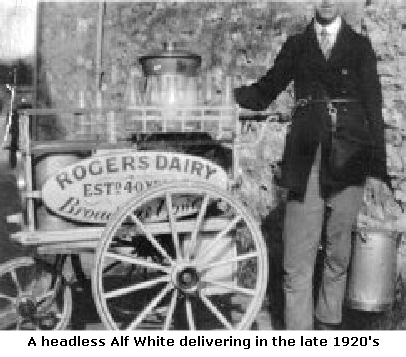
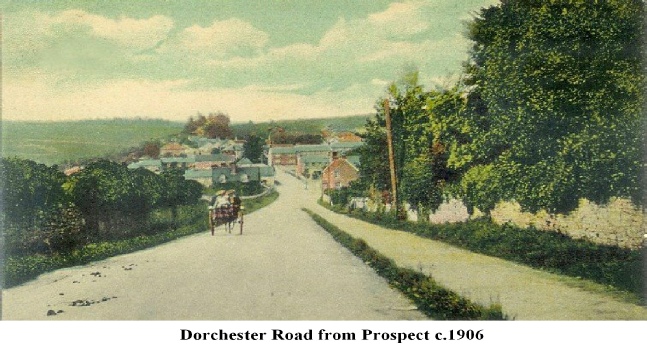
The Meech family ran the mill. The business was important to the village as it provided employment and bought grain from local farmers. Many of the mill workers lived in tied cottages. Charlie Pearce and Bill Wills were just two of the many local men who worked there.
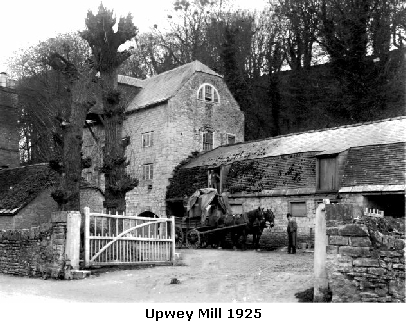
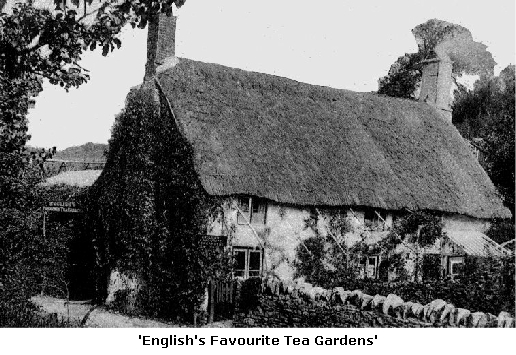
This end of the village was the main 'tourist' spot, with people coming from far and wide to visit the Wishing Well and enjoy cream teas. So it's not surprising to find that many locals grew soft fruit such as strawberries, raspberries and 'golden drop' gooseberries to serve to the visitors in season.
The most well known in the 1920's was English's tea gardens, situated at the top end of Church Street, (number 194 now occupies the site). To entertain the children Mr English provided a see-
The wishing well and tea gardens were owned by the Gould family of Upwey House. Those wishing to 'take the water' were served by one of five local people who wore a silver badge. The badge entitled them to sit at the well and serve water, any money taken was shared between the five badge holders.
Among those who 'watched the well' were Mrs Jolliffe, Mrs Newman, Mr Harris and Mrs Smith who had the honour of serving Edward, Prince of Wales when he visited the well in July 1923. To mark this great occasion school children were each presented with a medal and given an afternoon's holiday.
When Mr Ford came out of the navy in 1927 he rented the Wishing Well and English's tea gardens for approximately five years. The house was, by this time, unfit to be occupied so his family lived at 100 Church Street. His refreshing cups of tea, cakes, buns and cream teas were as much an attraction as the well itself, to the visitors brought to the well on the horse-
Miss Sarah Rogers took over as Headteacher at the school in September 1927, working with Miss Edith Lunn who took charge of the infants' room. Jack Beck was admitted to the school on 20 April 1928 aged 4. He recalls that Miss Lunn (from Martinstown) was very popular as she had a wonderful way with young children.
Attendance varied due as much to events happening in the village as illness. Whenever the circus visited the town or a fete or wedding held the school day book noted that attendance was down. Children were also kept away from school to help with the potato harvest or blackberry picking.
On Goulds Hill the first council houses in the village had been built in the late 1920's. Four pairs of semi-
Sundays were a very serious day. Sisters Bunty Gee and Evelyn Howell (nee Rogers) lived at Island Gardens in Church Street and remember there was Sunday school in the morning which finished at about 11am, followed by the church service. The younger children were allowed to go home before the sermon, but they'd be back again at 2.30pm for the children's service -
Children were not allowed out to play on a Sunday, their father used to take them on a route march, often going up to the hairpin bend to watch the traffic -
Mrs Jolliffe was the local nurse, she lived in cottages near the Mason's Arms, wore navy blue and carried a little black bag. Mrs King who lived at 104 Church Street, and Mrs Jarratt who lived in Victoria Avenue were midwives.
On the Dorchester Road things were beginning to happen. O W Baker ran a steam-
Evelyn Howell (nee Rogers) remembers being sent to the bakers to buy a cottage loaf. Living at Island Gardens she used the footpath between the disused chapel in Church Street and Prospect Place.
Although this was not far to go, the freshly baked bread proved too much of a temptation for her and she started to nibble the crust, by the time she got home all the crust was gone!
The Rev J Grey who came to the Congregational Chapel in 1918 bought a piece of land adjoining The Manse for £70 in 1921 to start his son in the petrol business. John Grey ran Wessex Carriers, doing haulage work with 2 or 3 lorries.
On a small plot of land next door was the WI Hut, which was the focus of social life in the village. The ex-
Brownies and Guides meetings were held there, one guide remembers that there were steep steps up to the door and that Miss Alice Mayo from Coryates was the Girl Guide Captain.
The District Nursing Association formed in 1921 to raise funds to pay for nurses were given free use of the hut for meetings, dances and jumble sales. Dr Pridham was a leading member of this association.
In the field next to the WI hut Les Shepstone built the Premier Garage which had two BP petrol pumps.
He provided cars for hire as well as employing mechanics and drivers. Bob Wills was one of the mechanics/drivers employed there in the 1920's. Very few people had telephones at this time and Les provided a very useful service proclaiming 'You may telephone from here'.
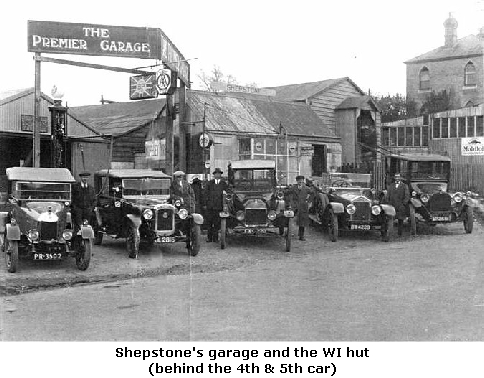
distance. If you knocked off the head-
The cricket team was quite famous in the area. They played on a pitch just beyond the railway bridge in Chapel Lane in a field belonging to farmer Arthur Virgin, who also made his long wagon barn available for teas. Mrs Johnnie Walker and ladies laid trestle tables with cups and saucers and provided cakes and sandwiches. Edith 'Toby' Pearce and Jean Hart were among several local youngsters who enjoyed helping out.
Other social clubs included a tennis club, a drama club, choral society and a rifle club which was based in Elwell Street.
Just beyond Virgin's dairy at the top of Chapel Lane, was the copse, where blue, white and mauve violets, primroses and daffodils grew. Another more accessible copse was Wards, a short walk over the Westbrook fields, here grew primroses, anemones, bluebells and wild orchids locally known as granfer griggles.
The village supported four public houses: John Marsh at the Masons Arms on Church Street; Percy Hyde at the Royal Standard on the Dorchester Road; Florence Wallace at The Ship on Ridgeway and J Dailey at the Royal Oak at the foot of Ridgeway. The Royal Oak closed on Sundays as it had a six-
At the side of the Royal Oak was a watering trough supplied by a natural spring, which provided a welcome drink for horses, cattle and sheep on their way to or from market. There would be much excitement among the locals when the circus was on its way to town as they always stopped here to water the elephants and other circus animals.
The village flower show was held in Stickland's field, just past Baker's shop. A marquee was filled with trestle tables for laying out entries. There was skittles, hoopla, lucky dip and the Upwey Brass Band, conducted by Captain Richards. A man dressed as an indian, face all smothered in brown/orange possibly iodine, would get into a big barrel. He wore an Indian head-
